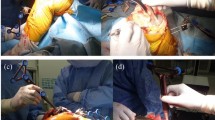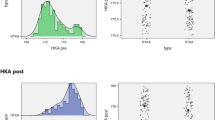Abstract
Purpose
The purpose of this study was to compare the precision of bony resections during total knee arthroplasty (TKA) performed using different computer-assisted technologies.
Methods
Patients who underwent a primary TKA using an imageless accelerometer-based handheld navigation system (KneeAlign2®, OrthAlign Inc.) or computed tomography-based large-console surgical robot (Mako®, Stryker Corp.) from 2017 to 2020 were retrospectively reviewed. Templated alignment targets and demographic data were collected. Coronal plane alignment of the femoral and tibial components and tibial slope were measured on postoperative radiographs. Patients with excessive flexion or rotation preventing accurate measurement were excluded.
Results
A total of 240 patients who underwent TKA using either a handheld (n = 120) or robotic (n = 120) system were included. There were no statistically significant differences in age, sex, and BMI between groups. A small but statistically significant difference in the precision of the distal femoral resection was observed between the handheld and robotic cohorts (1.5° vs. 1.1° difference between templated and measured alignments, p = 0.024), though this is likely clinically insignificant. There were no significant differences in the precision of the tibial resection between the handheld and robotic groups (coronal plane 0.9° vs. 1.0°, n.s.; sagittal plane 1.2° vs. 1.1°, n.s.). There were no significant differences in the rate of overall precision between cohorts (n.s.).
Conclusions
A high degree of component alignment precision was observed for both imageless handheld navigation and CT-based robotic cohorts. Surgeons considering options for computer-assisted TKA should take other important factors, including surgical principles, templating software, ligament balancing, intraoperative adjustability, equipment logistics, and cost, into account.
Level of evidence
III.

Similar content being viewed by others
Data availability
The data that support the findings of this study are not openly accessible, but may be made available from the corresponding author upon request.
References
Antonios JK, Korber S, Sivasundaram L, Mayfield C, Kang HP, Oakes DA et al (2019) Trends in computer navigation and robotic assistance for total knee arthroplasty in the United States: an analysis of patient and hospital factors. Arthroplast Today 5:88–95
Bendich I, Kapadia M, Alpaugh K, Diane A, Vigdorchik J, Westrich G (2021) Trends of utilization and 90-day complication rates for computer-assisted navigation and robotic assistance for total knee arthroplasty in the United States from 2010 to 2018. Arthroplast Today 11:134–139
Bonett DG (2002) Sample size requirements for estimating intraclass correlations with desired precision. Stat Med 21:1331–1335
Budhiparama NC, Lumban-Gaol I, Ifran NN, Parratte S, Nelissen R (2019) Does accelerometer-based navigation have any clinical benefit compared with conventional TKA? A systematic review. Clin Orthop Relat Res 477:2017–2029
Choi BS, Kim SE, Yang M, Ro DH, Han HS (2023) Functional alignment with robotic-arm assisted total knee arthroplasty demonstrated better patient-reported outcomes than mechanical alignment with manual total knee arthroplasty. Knee Surg Sports Traumatol Arthrosc 31:1072–1080
Clark G, Steer R, Wood D (2023) Functional alignment achieves a more balanced total knee arthroplasty than either mechanical alignment or kinematic alignment prior to soft tissue releases. Knee Surg Sports Traumatol Arthrosc 31:1420–1426
Costa-Santos C, Bernardes J, Ayres-de-Campos D, Costa A, Amorim-Costa C (2011) The limits of agreement and the intraclass correlation coefficient may be inconsistent in the interpretation of agreement. J Clin Epidemiol 64:264–269
Glowalla C, Langer S, Lenze U, Lazic I, Hirschmann MT, Hinterwimmer F et al (2023) Postoperative full leg radiographs exhibit less residual coronal varus deformity compared to intraoperative measurements in robotic arm-assisted total knee arthroplasty with the MAKO™ system. Knee Surg Sports Traumatol Arthrosc. https://doi.org/10.1007/s00167-023-07386-z
Golladay GJ, Bradbury TL, Gordon AC, Fernandez-Madrid IJ, Krebs VE, Patel PD et al (2019) Are patients more satisfied with a balanced total knee arthroplasty? J Arthroplasty 34:S195–S200
Gunaratne R, Pratt DN, Banda J, Fick DP, Khan RJK, Robertson BW (2017) Patient dissatisfaction following total knee arthroplasty: a systematic review of the literature. J Arthroplasty 32:3854–3860
Gustke KA, Golladay GJ, Roche MW, Jerry GJ, Elson LC, Anderson CR (2014) Increased satisfaction after total knee replacement using sensor-guided technology. Bone Jt J 96B:1333–1338
Hirschmann MT, Moser LB, Amsler F, Behrend H, Leclerq V, Hess S (2019) Functional knee phenotypes: a novel classification for phenotyping the coronal lower limb alignment based on the native alignment in young non-osteoarthritic patients. Knee Surg Sports Traumatol Arthrosc 27:1394–1402
Jones CW, Jerabek SA (2018) Current role of computer navigation in total knee arthroplasty. J Arthroplasty 33:1989–1993
Kannan A, Hawdon G, McMahon SJ (2012) Effect of flexion and rotation on measures of coronal alignment after TKA. J Knee Surg 25:407–410
Kayani B, Konan S, Ayuob A, Onochie E, Al-Jabri T, Haddad FS (2019) Robotic technology in total knee arthroplasty: a systematic review. EFORT Open Rev 4:611–617
Lei K, Liu L, Chen X, Feng Q, Yang L, Guo L (2022) Navigation and robotics improved alignment compared with PSI and conventional instrument, while clinical outcomes were similar in TKA: a network meta-analysis. Knee Surg Sports Traumatol Arthrosc 30:721–733
MacDessi SJ, Griffiths-Jones W, Chen DB, Griffiths-Jones S, Wood JA, Diwan AD et al (2020) Restoring the constitutional alignment with a restrictive kinematic protocol improves quantitative soft-tissue balance in total knee arthroplasty: a randomized controlled trial. Bone Jt J 102B:117–124
MacDessi SJ, Griffiths-Jones W, Harris IA, Bellemans J, Chen DB (2021) Coronal plane alignment of the knee (CPAK) classification. Bone Jt J 103B:329–337
Nam D, Nunley RM, Barrack RL (2014) Patient dissatisfaction following total knee replacement: a growing concern? Bone Jt J 96B:96–100
Nam D, Weeks KD, Reinhardt KR, Nawabi DH, Cross MB, Mayman DJ (2013) Accelerometer-based, portable navigation vs imageless, large-console computer-assisted navigation in total knee arthroplasty: a comparison of radiographic results. J Arthroplasty 28:255–261
Oussedik S, Abdel MP, Victor J, Pagnano MW, Haddad FS (2020) Alignment in total knee arthroplasty. Bone Jt J 102B:276–279
Pietrzak JRT, Rowan FE, Kayani B, Donaldson MJ, Huq SS, Haddad FS (2019) Preoperative CT-based three-dimensional templating in robot-assisted total knee arthroplasty more accurately predicts implant sizes than two-dimensional templating. J Knee Surg 32:642–648
Roussot MA, Vles GF, Oussedik S (2020) Clinical outcomes of kinematic alignment versus mechanical alignment in total knee arthroplasty: a systematic review. EFORT Open Rev 5:486–497
Schopper C, Proier P, Luger M, Gotterbarm T, Klasan A (2023) The learning curve in robotic assisted knee arthroplasty is flattened by the presence of a surgeon experienced with robotic assisted surgery. Knee Surg Sports Traumatol Arthrosc 31:760–767
Shalhoub S, Lawrence JM, Keggi JM, Randall AL, DeClaire JH, Plaskos C (2019) Imageless, robotic-assisted total knee arthroplasty combined with a robotic tensioning system can help predict and achieve accurate postoperative ligament balance. Arthroplast Today 5:334–340
Shihab Z, Clayworth C, Nara N (2020) Handheld, accelerometer-based navigation versus conventional instrumentation in total knee arthroplasty: a meta-analysis. ANZ J Surg 90:2068–2079
Swamy AM, Malhotra R, Digge V, Manhas V, Gautam D, Srivastava DN (2023) Accelerometer-based portable navigation, a faster guide compared to computer-assisted navigation in bilateral total knee arthroplasty-a randomized controlled study. Knee Surg Sports Traumatol Arthrosc 31:786–792
Funding
No funding was obtained for the current study.
Author information
Authors and Affiliations
Contributions
TSS study conception, methodology, data acquisition, statistical analysis, supervision, manuscript preparation. TJU data acquisition, statistical analysis, supervision, manuscript preparation. PJW data acquisition, statistical analysis, supervision, manuscript preparation. JSY data acquisition, statistical analysis, supervision, manuscript preparation. RC data acquisition, statistical analysis, supervision, manuscript preparation. DAM study conception, methodology, supervision, writing of initial manuscript, manuscript revision. SAJ study conception, methodology, supervision, writing of initial manuscript, manuscript revision. MPA study conception, methodology, supervision, writing of initial manuscript, manuscript revision.
Corresponding author
Ethics declarations
Conflict of interest
DJM receives royalties from Stryker, Smith and Nephew and OrthoAlign, and hold stock in OrthoAlign. SAJ receives royalties from Stryker. MPA is a paid consultant for Stryker, Smith and Nephew and OrthoAlign and recieved royalties from OrthoAlign. The remainder of the authors certify that he or she has no commercial associations (e.g., consultancies, stock ownership, equity interest, patent/licensing arrangements, etc.) that might pose a conflict of interest in connection with the submitted article.
Ethical approval
This study was approved by the Hospital for Special Surgery Institutional Review Board (IRB).
Additional information
Publisher's Note
Springer Nature remains neutral with regard to jurisdictional claims in published maps and institutional affiliations.
Rights and permissions
Springer Nature or its licensor (e.g. a society or other partner) holds exclusive rights to this article under a publishing agreement with the author(s) or other rightsholder(s); author self-archiving of the accepted manuscript version of this article is solely governed by the terms of such publishing agreement and applicable law.
About this article
Cite this article
Shen, T.S., Uppstrom, T.J., Walker, P.J. et al. High degree of alignment precision associated with total knee arthroplasty performed using a surgical robot or handheld navigation. Knee Surg Sports Traumatol Arthrosc 31, 4735–4740 (2023). https://doi.org/10.1007/s00167-023-07495-9
Received:
Accepted:
Published:
Issue Date:
DOI: https://doi.org/10.1007/s00167-023-07495-9




